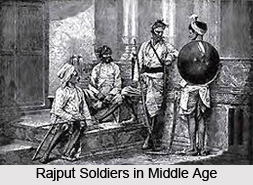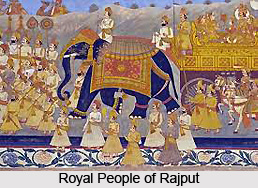 In Rajput society most of the Indian traditions and customs are followed. Anybody who commits a punishable offence is not exempted, even if it is a Brahmin. There are limits defined within which corporal punishment is permissible for Brahmins. The general view is that one is not to be blamed for killing a Brahmin but it holds good only when it is impossible to save one`s self and not otherwise.
In Rajput society most of the Indian traditions and customs are followed. Anybody who commits a punishable offence is not exempted, even if it is a Brahmin. There are limits defined within which corporal punishment is permissible for Brahmins. The general view is that one is not to be blamed for killing a Brahmin but it holds good only when it is impossible to save one`s self and not otherwise.
Though we hear of "Swayamwara" in Rajput times, which give an impression of adult marriages, in reality, the age of marriage was much earlier, as per the tenets of Manu Smriti, and child marriages were rampant. During the Rajput period the women were given a much better position as compared to their position in the other ages. As regards the position of the wife, she should be guarded not only against physical but also against mental torture for the sake of her offspring. Practice of polygamy was common.
The Brahmanic authors, poets and bards have not only glorified "Sati", they have glorified "Jauhar" also, which was a mass suicide in order to escape ruination at the hands of a victorious enemy. They were made to believe that this was worse than death. There are examples in Rajput history when women entered the fire to save their honour.
 Agriculture was the main profession of the upper classes. While the poor toiled as free labour for temples, forts, palaces construction and also reservoirs, tanks, wells and canals erection in time of famine and drought. Trade and commerce flourished during the Rajput period. Big cities were linked up with roads. The people were wealthy and prosperous. The upper castes lived in grand buildings and enjoyed all kinds of appeasements. There were festivals and fairs throughout the year. Music, dancing, drama, dice, hunting, chess, etc. were favourite hobbies.
Agriculture was the main profession of the upper classes. While the poor toiled as free labour for temples, forts, palaces construction and also reservoirs, tanks, wells and canals erection in time of famine and drought. Trade and commerce flourished during the Rajput period. Big cities were linked up with roads. The people were wealthy and prosperous. The upper castes lived in grand buildings and enjoyed all kinds of appeasements. There were festivals and fairs throughout the year. Music, dancing, drama, dice, hunting, chess, etc. were favourite hobbies.
Caste system was rigid during the Rajput period. Though this was not so initially, it came on gradually. Brahmans played the most important part in bringing about this caste- based division. They stopped marrying among themselves. During this period a large number of new castes, sub-castes came into existence. Many new occupational castes such as weavers, smiths, fishermen, brewers, cow-herds and carpenters came into being. A new caste known as that of the Kayasthas also appeared its main function being clerical. Rajputs supported Brahmins as scholars and priests. However, they had their own family priests, known as Purohits. The high standard of living, which prevailed among the upper classes in the preceding period, was maintained during these centuries. The rigidity of the Caste system is the legacy of the Rajput period. The women were given a better position during this though all malpractices were not done away with. The standard of living prevalent among the upper classes was fairly high reaching a level of incomparable magnificence among kings.



















